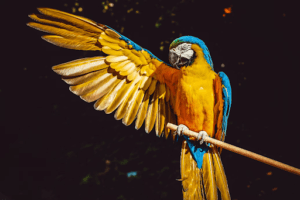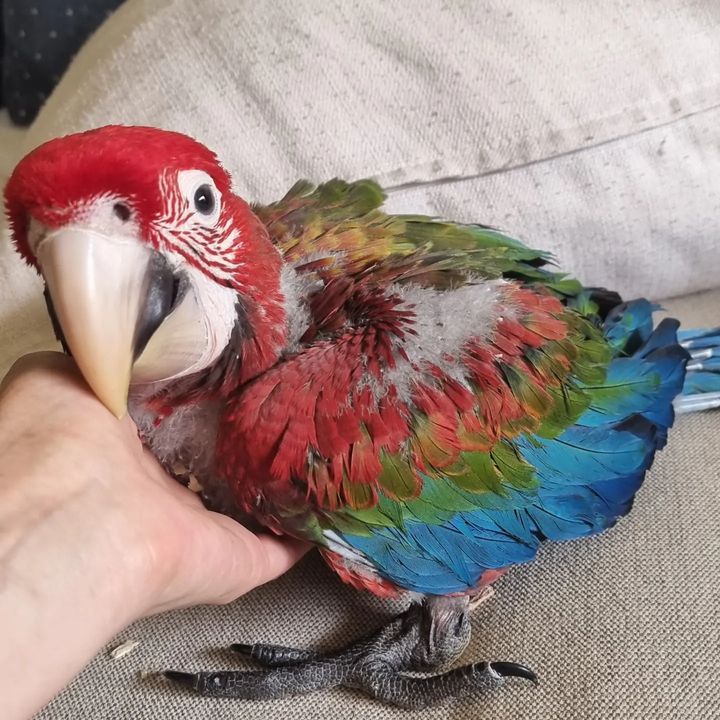
- 1 year health guarantee for all our exotic pets on sale
- [email protected]
Macaw parrots, renowned for their vividly colored plumage and captivating personalities, are among the most striking avian species.
Native to tropical regions of North and South America, these large parrots are not only admired for their beauty but also for their social and intelligent nature.

Photo by Kinga Howard on Unsplash
This guide delves into the fascinating world of macaws, offering insights into their unique characteristics, habitat, behaviors, and more, to deepen your appreciation for these majestic birds.
Macaws, known for their striking colors and impressive size, have a history as vibrant as their feathers.
Originating from the neotropical regions, primarily in Central and South America, these parrots have been part of human culture for millennia.
Evidence of their significance dates back about 5,000 years, with cave paintings in Brazil depicting these majestic birds.
Europeans first learned about macaws from Christopher Columbus’ journey logs in the 15th century, marking the introduction of these “New World” parrots to the Old World.
Over time, several species of macaws have become endangered, and some are on the brink of extinction, underscoring the delicate balance they maintain in their native habitats and the impact of human interaction on their survival
Macaws are distinguished by their strikingly colorful feathers, which vary from bright reds and blues to vibrant greens and yellows.
These long-tailed birds belong to the Psittacidae family, and their size can vary significantly.
The larger species, like the military and hyacinth macaws, can grow up to 42 inches including their tails, while mini macaws are more manageable, ranging from 10 to 20 inches in length.
Interestingly, both male and female macaws appear similar, which is rare among brightly colored birds.
Macaws thrive in tropical environments, often found in rainforests, woodlands, and savannas. These habitats provide the necessary resources, such as food and nesting sites.
Macaws are known for their complex social behaviors and strong pair bonds, often seen in flocks.
They communicate through a range of vocalizations and are adept at mimicking human speech.
Their intelligence and playful nature make them engaging companions, though this intelligence means they require mental stimulation to prevent boredom and destructive behavior.
Macaws have a varied diet, primarily consisting of nuts, seeds, fruits, and sometimes nectar and insects. In captivity, it’s crucial to provide a balanced diet to maintain their health.
They also need ample space for exercise and play. Due to their intelligence and social nature, macaws require regular interaction and mental stimulation.
Inappropriate care can lead to stress and behavioral issues, such as biting and stereotypic behaviors, which can result in the need for rehoming.
Therefore, potential owners should be well-prepared for the complex care needs of these birds.
Exploring the world of macaws uncovers a rich tapestry of ecological roles, conservation challenges, and cultural significance.
These vibrant birds, known for their intelligence and social behaviors, play an integral part in both natural ecosystems and human cultures.
This section delves into three critical aspects of macaw parrots, offering insights into their environmental impact, the threats they face, and their symbolic meanings across various cultures.
Macaws are crucial for maintaining the health of tropical ecosystems, particularly in the Amazon.
As seed dispersers, they play a pivotal role in shaping the landscape.
Macaws, like the blue-and-yellow macaw (Ara ararauna), the blue-throated macaw (A. glaucogularis), and the chestnut-fronted macaw (A. severus), are the primary dispersers of large-seeded plants such as the motacú palm in the Bolivian Amazonian savannas.
They contribute to forest regeneration by dispersing seeds over long distances, thus maintaining the diversity and connectivity of forest ecosystems.
Macaws face significant conservation challenges, primarily due to habitat loss and illegal wildlife trade.
In Mexico alone, all 22 native species are at risk, with many classified as endangered or threatened.
The illegal parrot trade is devastating, with a high mortality rate among captured birds.
Despite efforts to curb this trade, it continues to pose a substantial threat to macaw populations.
Conservation initiatives, such as protecting nests and reintroducing birds into the wild, have been instrumental in increasing the populations of species like the military macaw and scarlet macaw in Mexico.
Macaws hold profound cultural significance across different societies.
In Native American culture, they symbolize joy, happiness, and good fortune and are considered sacred.
Their vibrant red and yellow feathers associate them with the sun, light, and warmth.
In Celtic culture, macaws represent communication, eloquence, and intelligence, likely due to their ability to mimic human speech.
They are also seen as symbols of hope and liberation, embodying the power of renewal and fidelity.
Macaws are not only a symbol of natural beauty but also play a pivotal role in our ecosystems and cultures.
Their vibrant colors and remarkable behaviors captivate us, while their ecological contributions and cultural significance deepen our understanding and appreciation of these extraordinary birds.
The challenges they face, primarily due to habitat loss and illegal trade, highlight the urgent need for conservation efforts.
By recognizing the importance of macaws, both in nature and in various cultural contexts, we can better appreciate their value and work towards ensuring their survival for future generations.
Macaws are more than just parrots; they are a testament to the intricate connections between wildlife and human societies, reminding us of the responsibility we bear in preserving the natural world.


If you are interested in purchasing a pet macaw parrot then click the button below to get to our available macaw parrots for sale page.
Copyright © 2025 Compound Exotics All Rights Reserved.